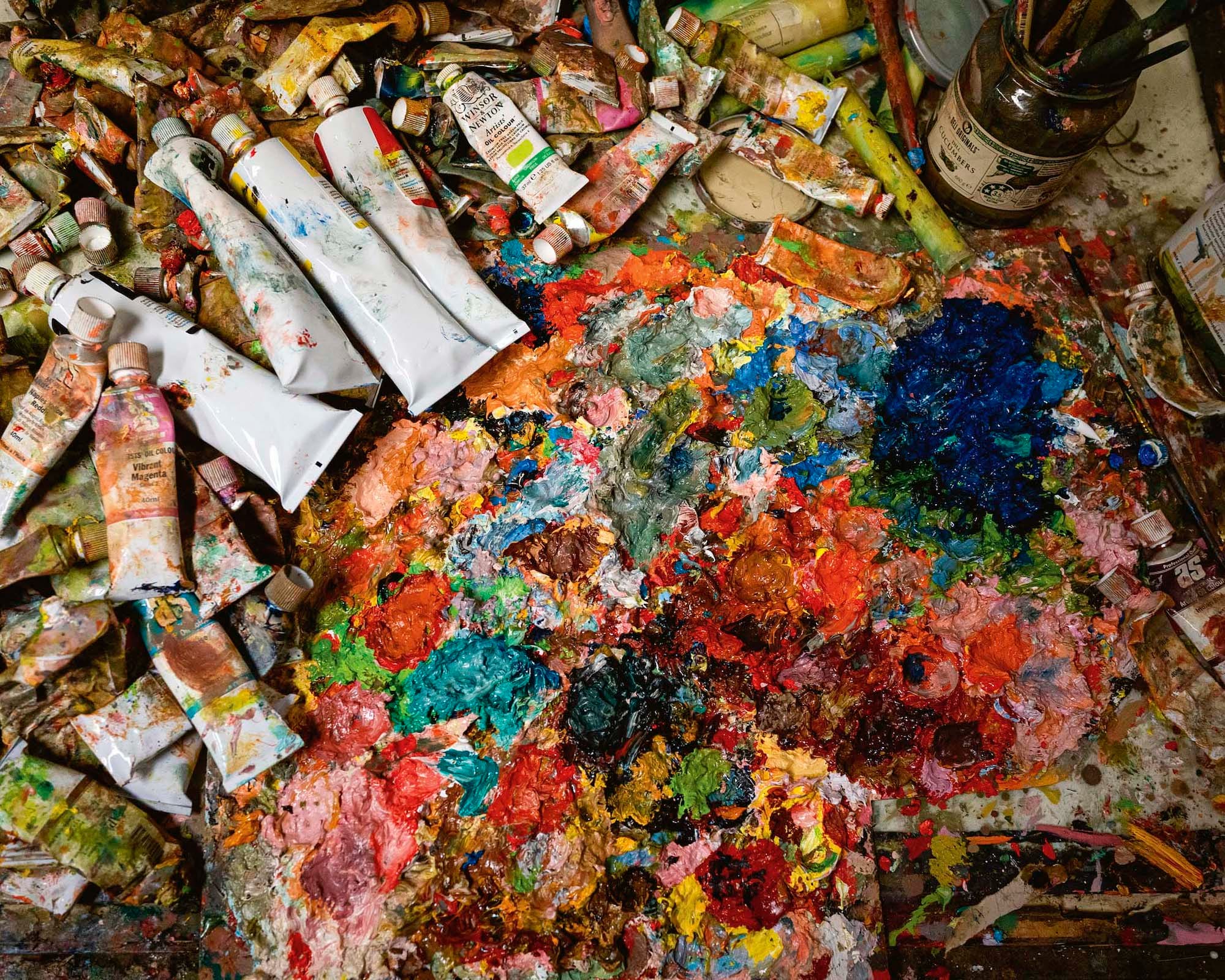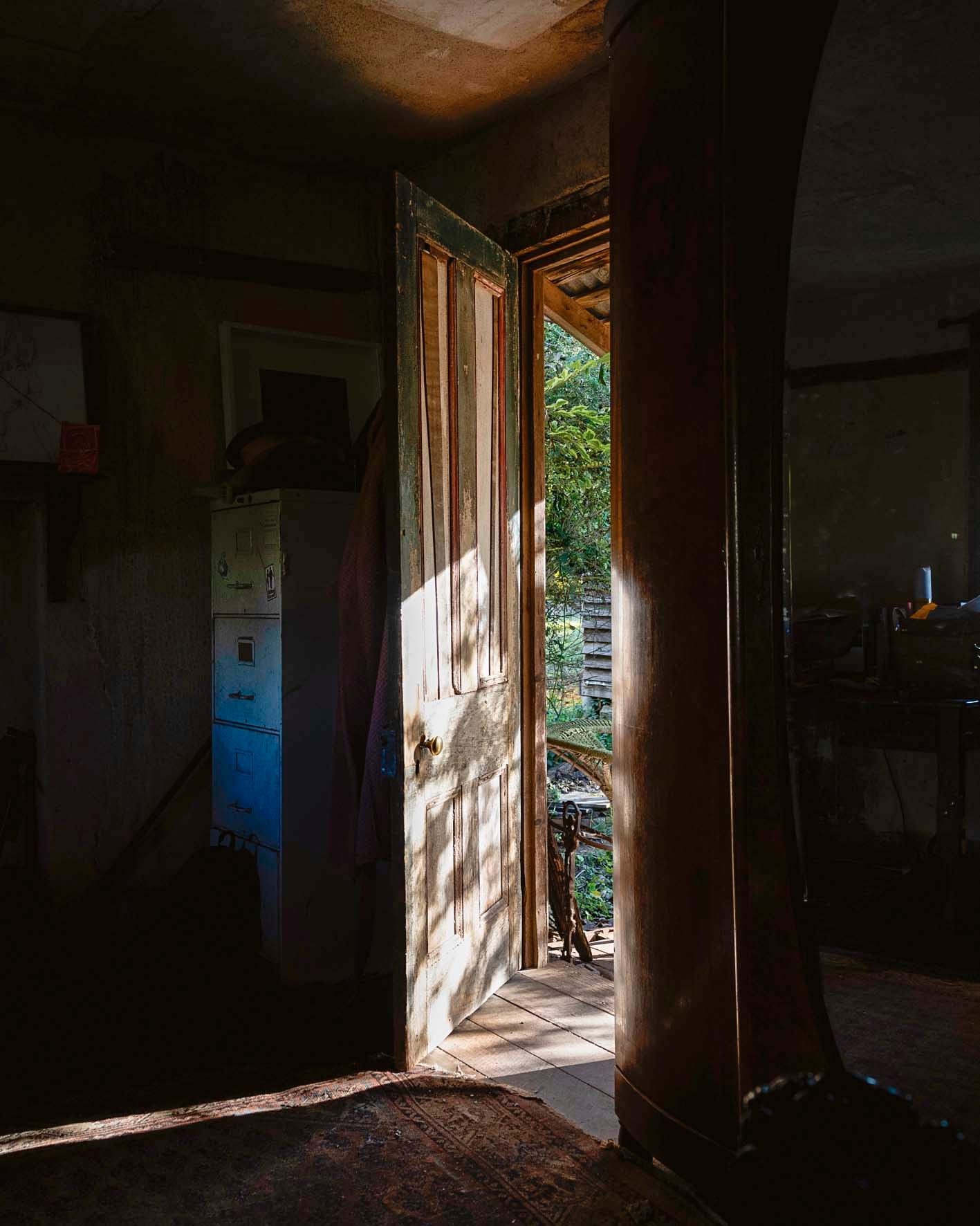
A ruin in Hill End has become many things to Genevieve Carroll and Bill Moseley: a muse, an installation, a 20-year challenge, and a home.
Words Sarah Turnbull
Photography Hugh Stewart
A CURIOUS display hangs above the fireplace in the rustic kitchen of artists Genevieve Carroll and Bill Moseley. It doesn’t resemble an artwork so much as a Driza-Bone jacket, inexplicably squashed behind glass and framed. It takes a close look to see a child’s sailor suit, a piece of crude embroidery that once adorned a small dress, a flash of faded turquoise thread.
“I thought they were rats’ nests at first,” says Carroll, pointing to the earthen wall where she discovered the clothing stuffed into gaps to stop the cold. It turned out the discoloured items date back to the 1870s, when Hill End was a booming gold-rush town and the cottage was home to publican William English, his wife and their 11 children.
Carroll, who paints, sculpts and writes poetry, was “over the moon”. “It was really moving to touch things that were sewn and worn so long ago, to know
they’d been put to another purpose when they no longer fit,” she says. “It made me feel more connected to the house.”
The English Cottages, named after the original family, is a collection of four small dwellings among pear and lilac trees. Brick chimneys, corrugated-iron roofs and wattle-and-daub façades form a characterful collage of materials and textures. But 20 years ago, when the artists first saw the place, holes in the walls were the least of its problems. Over coffee, they show me photographs of an unpromising ruin overgrown with blackberries. “It’d been empty for 50 years,” Moseley says. “There was no power and water; the roof had fallen in.”




Artworks and framed photography cover the crumbling walls of the cottage, which had been empty for 50 years before the couple moved in. “There was no power and water; the roof had fallen in,” says Moseley; The couple in the kitchen at the English Cottages, under the Sheep Dung Chandelier. Photography by Hugh Stewart.
Eager for a change from city life, the Sydney-based artists were undeterred. Under a conservation scheme, the NSW National Parks and Wildlife Service was offering long leases and negligible rents to artists willing to undertake renovations at their own expense. Moseley, who trained as a shipwright before studying printmaking and photography at the National Art School, applied his building experience to the house. For several years they commuted from Sydney, working and camping on the property, where they bathed in tubs of cold water. “We love a project,” laughs Carroll. “We’re adventurous.”
A sense of adventure is essential in Hill End, a remote town about 80 kilometres north of Bathurst along winding roads. Isolation and harsh winters pose challenges, as do the historical, segmented dwellings; for Moseley and Carroll, going to the toilet on cold nights means a bracing dash outside. The primitive walls are constantly crumbling; inside, daylight forks dramatically through a fresh crack. Windows are small; rooms are dark. Yet the atmosphere is anything but sombre.
In the kitchen, we eat under the wonderful Sheep Dung Chandelier. Carroll sewed and stuffed each “dung” piece in fond memory of her uncle’s farm near the Monaro village of Michelago. On walls painted sage and gold, Moseley’s landscape photographs convey a timeless beauty. Lush blacks and ethereal silvery tones are attained through antiquarian methods such as photogravure and wet-plate photography. Adding to the lively miscellany are paintings and items collected on travels, as well as gold-era bottles and ceramics dug up in the garden.
“For us, there’s no separation between life and art,” says Carroll, whose large hair bows express spirited playfulness and a desire to spread joy. “The house was one big art project.”


Hill End has drawn artists since the 1940s, when Russell Drysdale and Donald Friend were captivated by the rugged landscape and abandoned gold-rush buildings. Margaret Olley, John Olsen and Brett Whiteley followed. Carroll is part of a later influx of contemporary Australian painters, including Rosemary Valadon and Luke Sciberras. When I visit, she’s preparing for a solo exhibition in Sydney and the studio she shares with Moseley throbs with rich pinks and oranges, luminous blues and greens. “Winters here are long,” Carroll says. “Colour is necessary.”
A pair of rabbits against a sequinned night sky; mushrooms with spotted red caps (hallucinogenic fly agarics); gluttonous rats... her exuberant canvases
offer the natural world through an Alice in Wonderland lens. In still-life works, cups clamber over rocks, jugs teeter on table edges. The paintings are a visual diary of life in Hill End: the jug, which represents the artist, looks to me both resolute and vulnerable.
Carroll admits that beneath the whimsy there are deep emotional layers to her work, influenced by writers such as Virginia Woolf and Samuel Beckett, though talking about the lighter aspects comes more easily. “I don’t think twice about making kooky things,” she says. Her father worked in the fashion industry and Carroll recalls how he would come home from work and, still in his suit, paint murals – topiary trees up the stairwell, a circus in her bedroom. Her mother instilled a passion for still lifes. “My parents always encouraged me to be myself,” says Carroll. “It was never ‘why are you making that?’ or ‘you can’t’ – even if it was absurd.”
Family also nurtured Moseley’s creativity. His parents ran a boarding house in Sydney’s eastern suburbs and his father was a talented painter. In 1947, Charles Moseley was a finalist for the Archibald Prize. Yet it was a trip to Japan in 2007 that helped the couple see the possibilities for Hill End. Naoshima, a once depopulated fishing island that has forged a new identity as a modern art destination, was a revelation. Inspired, they set up the Hill End Press, which produces high quality prints for artists as well as greeting cards designed by local children. “You don’t come home and copy what you saw,” says Moseley. “But going there definitely opened our eyes. We saw how Hill End could become a creative centre.”




Inside the English Cottages, where rooms are dark and winters are long yet anything but sombre; The artists relax amid their creations and items collected on travels in France and Japan. Photography by Hugh Stewart.
The historic village has a chequered history – thriving gold-mining town, ghost town, and now home to roughly 100 artists and locals. During my visit I see many more kangaroos than people. But over a November weekend last year, the place hummed with activity. The inaugural Hill End Analogue Festival, initiated and organised by Moseley, drew visitors from across regional New South Wales, as well as from Sydney. Guest artists – filmmakers, photographers, musicians – gave talks and took part in exhibitions. At workshops, local sheep farmers learnt printmaking along with city folk. Many in the community worked as volunteers, an experience Carroll says was “wonderfully consolidating”.
Unlikely as it sounds, the festival has launched Hill End onto an international stage. Bathurst Regional Council has committed funding for a biennial event and artists from around the world have already applied to attend next year. Softly spoken Moseley grows animated telling me how the Central Tablelands village is now part of a broader analogue revival that includes festivals in Rio de Janeiro, Rotterdam and San Francisco.
The renewed interest is embedded in a deeper philosophy; Moseley says analogue images convey a sense of depth that is “more in tune with nature”. “With these traditional methods, it’s a wondrous creation every time you do something,” he says. “It’s the opposite of hitting command on a printer. You never know how something will turn out.”
Importantly for Moseley, the festival connects with Hill End’s heritage. In 1872, German prospector Bernhardt Holtermann’s mining syndicate discovered the world’s largest specimen of reef gold (93 kilograms) at Hill End. He then used part of his fortune to commission a remarkable archive of wet-plate images taken in gold-rush towns during the boom years. The Holtermann Collection (unearthed in a garden shed in the Sydney suburb of Chatswood in 1951) is now housed at the State Library of New South Wales.
After a few hours at the English Cottages, I drive with Carroll through the heritage-protected village, past the Royal Hotel, to the eastern outskirts where some years ago the couple bought a plot of land. Their latest collaboration, still under construction, is perhaps their most ambitious. Designed by Cowra-based architect Dylan Gower, the soaring home creates an elegant convergence of angles and diagonals against the sky. Incredibly, Moseley and Carroll have largely built it themselves, with help from local sculptor Hui Selwood. After seven years – an arduous Grand Designs experience, by the sound of things – earlier this year they appointed two Sydney builders to finish the project. The couple will move in before the year’s end but hope to maintain their studio at the old property and use the cottages to hold residencies for printmakers.



The new architect-designed home, where they will move before year’s end; Beyers Avenue was planted in Hill End’s gold-mining heyday; Carroll at the cottages, where they will maintain a studio and hope to hold residencies. Photography by Hugh Stewart.
The bold building strikes me as an apt metaphor for the artists’ unflagging sense of adventure. Light-filled and spacious, it’s a culmination of lifelong passions. Although unlike anything else in the area, the home reflects what Moseley calls “the Hill End vernacular”. The dynamic roofline recalls the saw-tooth design of the industrial gold-rush buildings. The entrance walkway is inspired by the trolley tracks that once led into mines; sheets of rusted Corten steel echo the corrugated-iron roofs of nearby 19th century cottages. Inside, surfaces are left raw and exposed like the modern interiors that excited the couple in Japan.
Yet the home also heralds a radical change. Solid and sealed with grand double-glazed windows, it’s a far cry from crumbling clay-and-stick walls stuffed with old sailor suits and dresses. “No more having to wear beanies and coats inside in winter,” chirps Carroll, and the big bows nod delightedly. “It feels like we’re in a grown-ups’ house.”